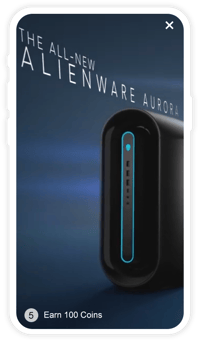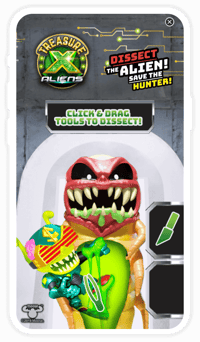6 Ways to Monetize Your App with Ads
December 8, 2022
Editorial Policy
All of our content is generated by subject matter experts with years of ad tech experience and structured by writers and educators for ease of use and digestibility. Learn more about our rigorous interview, content production and review process here.

Key Points
- As an app developer, you can monetize your mobile app in a variety of ways.
- Subscriptions, paid downloads, and in-app sales are a few of the most common app monetization methods.
- The most common - and most profitable - way to monetize an app, especially a free app, is through in-app ads.
Mobile app revenue approached $613 billion in 2025. Most apps are free to download, so it's safe to assume that a large portion of that revenue came from in-app ads. It's also safe to assume that mobile app ad revenue will continue to climb as smartphones become more common and people spend more time using them each day.
It's not hard to see the revenue potential in in-app advertising. What may be more difficult for some publishers is getting from Point A (wanting to sell in-app ad inventory) to Point B (actually getting ads on your app in a profitable way).
To help app publishers get started on their in-app ad monetization journey, our team of in-app ad revenue experts put together a brief guide, which includes 6 of the best ways to monetize your app with ads including:
Read on to learn more, or contact the team to discuss your app revenue or app monetization strategy.
Want to learn everything you need to know about monetizing apps? Download Playwire’s Complete Guide to App Monetization for Publishers.
-- Article Continues Below --
Read The Complete Guide to App Monetization for Publishers.
Mobile Banner Ads
If you've used the internet in the past quarter century, you've seen these before. Banner ads commonly appear in headers, footers, and sidebars on desktop websites. In apps, publishers designate areas where ad servers can place a banner ad, taking care to place them in visible spots that won't detract from the user experience (UX).
Native Ads Inside Your App
Native ads are meant to match the look and feel of your app. In a news app, for example, a native ad may look like another news story, but it's actually ad content from an advertiser. These ads are often marked with a "sponsored" tag or similar descriptor.
Interstitial Ads Between App Use Phases
Publishers who would prefer to not have ads visible alongside their app's content might find interstitial ads appealing. These ads cover the entire screen, so they're highly visible, but they only appear in between phases of the app's use. For example, in a mobile gaming app, an interstitial ad could appear to the app user before a game starts, between levels, or after a game ends.

Rewarding App Users Who View an Ad
When they're done right, rewarded video ads can be an effective mobile app monetization strategy that can seriously boost ad metrics like video ad completion rate. That's because an app user will get something in exchange for viewing the video ad. Often, the reward is in-app currency, points, extra lives, or exclusive items to use inside a mobile game.

Gamified In-App Ads
Playable mobile ads are a premium in-app ad offering you can only get with high-end ad partners. Put simply, a gamified mobile ad is a mini-game advertising something else - most often a mobile gaming app. This ad format works especially well in the app world because the vast majority of in-app ads are advertising other apps.

Removing Ads from Your App
This in-app ad monetization strategy works alongside any of the above advertising methods. Here's the basic idea: you have ads on your app, but you offer a premium feature where app users that are willing to pay a one-time or recurring fee, through an in-app purchase, can have an ad-free experience. Many users may be willing to pay to not see ads while using your app, but those who aren't will still bring revenue through your other app advertising efforts.
-- Article Continues Below --
Read the Complete Guide to Ad Monetization.
How to Run Ads Inside Your App
The above app advertising strategies are exciting, but how do you actually get ads on your app and make money from them? Even in the technology-first world of mobile apps, it is still possible - and sometimes beneficial - to do direct ad sales with a traditional sales team. These are the insertion order (IO) buys many publishers are used to.
However, if you plan to scale up and don't want to rely solely on direct sales, you need to consider programmatic advertising as part of your mobile app monetization strategy. The vast majority of digital ad dollars in the United States go through programmatic deals.
Programmatic advertising is a broad term that encompasses a wide variety of digitized and automated ad sales, including standard programmatic, programmatic guaranteed, programmatic preferred, private marketplaces, and open exchanges.
Implementing a programmatic ad sales strategy for your mobile app is a complicated and in-depth process (if you want to do it right). You'll need to incorporate multiple software development kits (SDKs) for each mediation partner you want to include.
This can become a rather large effort, depending on the number of partners you want competing for your inventory. Choosing a monetization partner like Playwire allows you access to all partners in a single SDK integration, increases the competition between partners, and ultimately improves your yield.
Additional App Monetization Strategies
Keep in mind that ads are not the only mobile app monetization method.
Some additional mobile app monetization methods include:
- Paid App: Monetizing Your App with a Download Fee
- App Subscription Model to Bring in Consistent Revenue
- Flexible App Monetization with 'Freemium'
- Affiliate Marketing for Your App
- Monetizing Through In-App Purchases
- App Data Monetization
- App Transaction Fees
Rev Up Your Mobile App’s Advertising Revenue with Playwire
At Playwire, we spend a lot of time - some might say too much time - thinking about how to bring in more revenue for app publishers. It's a huge part of what we do, and we're ready to make more in-app ad revenue a reality for you in 2021.
To get started with app monetization via ads, reach out to Playwire. Give us a call at 1-561-206-4621 or contact us online.
Frequently Asked Questions: App Monetization
Let’s answer some questions on app monetization.
Why is mobile app monetization important for developers?
Mobile app monetization is important because it enables developers to generate revenue from their work, sustain ongoing development, and build a profitable business. With over 3.5 million apps on the Google Play Store alone, having a solid monetization strategy is essential for app sustainability and growth. Without effective monetization, even the most successful app in terms of user downloads may fail as a business venture.
What are the most popular app monetization models in 2025?
Several app monetization models have proven effective across both iOS apps and Android applications in the Google Play Store:
- In-app advertising: Displaying ads within your app (banner ads, interstitials, rewarded videos)
- In-app purchases model: Selling virtual goods or features within a free app
- Subscription model: Charging recurring fees for continued access or services
- Freemium model: Offering basic features for free while charging for advanced functionality
- Paid app: Requiring payment before users download your app
- Hybrid approach: Implementing multiple monetization models simultaneously
The most effective strategy often involves combining multiple monetization models tailored to your specific target audience and app category.
How do I choose the right app monetization model for my app?
Selecting the appropriate app monetization model depends on several factors:
- Target audience analysis: Understand your users' spending habits and preferences
- App category: Different categories perform better with different models (games vs. productivity)
- User acquisition strategy: Consider how monetization affects user growth
- Competitor analysis: Research what works for successful apps in your niche
- User experience impact: Ensure monetization doesn't negatively affect engagement
For example, productivity apps often succeed with the subscription model, while casual games may perform better with advertising and in-app purchases.
What's the difference between freemium and subscription models?
The freemium model provides basic features free of charge while offering premium features for a one-time payment. Users can continue using the basic version indefinitely. In contrast, the subscription model charges recurring fees (monthly/annually) for continued access to the app or specific features, often with a free trial period.
While freemium focuses on converting users to premium through feature limitations, subscriptions emphasize ongoing value delivery to maintain renewals. Both models can effectively generate revenue when aligned with user expectations and value perception.
How much revenue can in-app advertising generate?
In-app advertising revenue varies widely based on factors including:
- Your app's user base size and geographic distribution
- User engagement levels and session length
- Ad format types (rewarded video typically generates more than banners)
- Ad network partnerships and fill rates
- Your app category and target audience demographics
For context, average banner ad CPMs range from $0.50-$2.00, while rewarded video can reach $10-$20 CPMs for apps with engaged U.S. audiences. Working with multiple ad networks can maximize fill rates and optimize ad spending from advertisers targeting your specific audience.
Should I offer an ad-free version of my app?
Offering an ad-free version as a premium option can create an additional revenue stream while improving user experience for those willing to pay. This approach acknowledges different user preferences—some prefer free access with ads, while others value an uninterrupted experience enough to pay for it.
When implementing this strategy, consider:
- Pricing the ad-free version appropriately based on competitive analysis
- Highlighting the enhanced experience beyond just removing ads
- Maintaining ad quality standards in the free version to encourage conversions
This model works particularly well when your app has strong user engagement, as frequent users are more likely to upgrade to eliminate ads.
How do in-app purchases compare to subscription models?
In-app purchases provide one-time transactions for virtual goods or features, while subscriptions generate recurring revenue through regular payments. Here's how they compare:
In-App Purchases | Subscription Model |
| Higher one-time revenue | Predictable recurring revenue |
| Lower barrier to initial conversion | Higher customer lifetime value |
| Great for impulse purchases | Better for services with ongoing value |
| Popular in gaming apps | Effective for content and productivity apps |
| Requires continuous new purchase options | Focuses on retention and reducing churn |
Many successful apps implement both models, using in-app purchases for immediate revenue while building a subscriber base for long-term stability.
How can I maximize user engagement to improve monetization?
User engagement directly impacts monetization effectiveness across all models. To enhance engagement:
- Develop a deep understanding of your target audience's needs and preferences
- Create compelling content and features that provide genuine value
- Implement effective onboarding to demonstrate app benefits quickly
- Use push notifications strategically (not excessively) to bring users back
- Regularly update your app with new features and content
- Incorporate gamification elements to increase retention
- Gather and respond to user feedback to continuously improve
Higher engagement levels lead to more ad impressions, increased in-app purchase conversions, and better subscription retention rates.
How do I balance monetization with user experience?
Finding the right balance between generating revenue and maintaining positive user experience is crucial for long-term success. Consider these principles:
- Prioritize value delivery before monetization attempts
- Implement non-intrusive ad formats that respect user flow
- Ensure premium features offer genuine value worth the price
- Test monetization strategies with small user segments before full rollout
- Collect and analyze user feedback specifically about monetization elements
- Monitor key metrics like retention rates when implementing new monetization features
Remember that sacrificing user experience for short-term revenue gains often backfires through decreased retention and negative reviews in the app store.
What monetization approaches work best for new apps versus established apps?
New apps with small user bases often benefit from different approaches than established apps:
For new apps:
- Focus on user acquisition and engagement before aggressive monetization
- Implement lightweight monetization (unobtrusive ads or basic in-app purchases)
- Consider a paid app model if targeting a specific niche with clear value proposition
- Use monetization data to learn about user preferences and behavior
For established apps:
- Leverage user data to optimize existing monetization channels
- Experiment with additional monetization models to diversify revenue
- Implement more sophisticated strategies like dynamic pricing or personalized offers
- Consider exclusive access or premium features for loyal users
As your user base grows, gradually expand your monetization strategy while carefully monitoring user response.
How important is app store optimization for monetization success?
App store optimization (ASO) is critical for monetization success because it directly impacts user acquisition, which provides the audience foundation for all revenue generation. Effective ASO:
- Increases visibility in app store search results
- Attracts more qualified users likely to convert to paying customers
- Improves download-to-install conversion rates
- Communicates your value proposition effectively
- Sets appropriate expectations about monetization models
Focus on optimizing your app title, description, screenshots, and keywords to attract users who align with your monetization strategy. For example, if you have a subscription model, your store listing should clearly communicate the value of your premium features to attract users willing to pay for them.
More Content About In-App Ads
Browse some of our other articles about app advertising:
- How to Drive App Ad Revenue
- In-App Advertising Cost Breakdown: From Investment to ROI
- In-App Advertising with Google AdMob
- 5 Mobile App Video Advertising Tips
- A Guide to Mobile App Advertising
- The 8 Best Advertising Practices for App Developers
- App Monetization: Building Your App Advertising Revenue
- In-App Advertising Revenue Models: CPA vs. CPM
- Where to Begin with Your In-App Advertising
- In-App Advertising: Mobile Apps vs. Desktop Apps
- 5 In-App Advertising Revenue Models
- How Playwire is Changing the Face of In-App Ad Monetization

-1.png?width=800&height=157&name=1-playwire-logo-primary-2021%20(1)-1.png)





